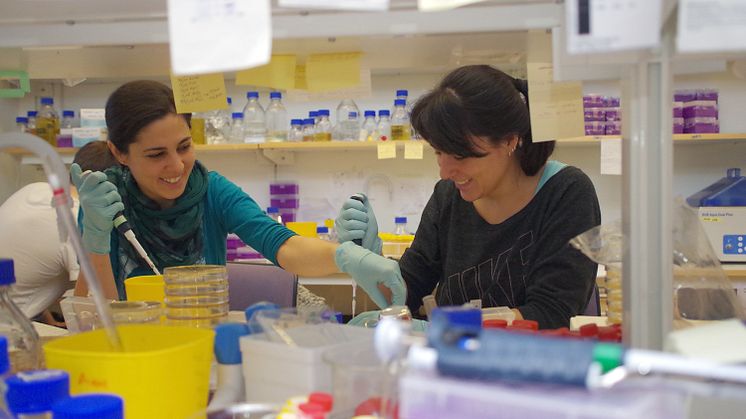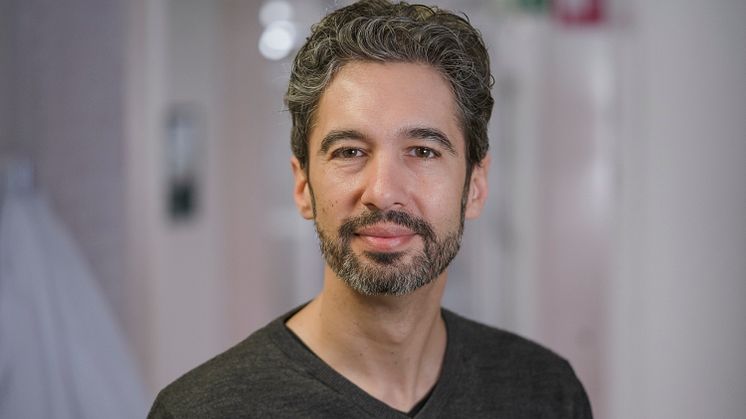
Press release -
Study unveals a novel protective mechanism in bacterial cell wall
Researchers from Umeå University, Sweden, and Cornell University, USA, have discovered a widespread mechanism in bacteria that enhances the bacteria's defense against environmental threats. The discovery, which may be important for research into developing new treatments, shows how a specific crosslinking mode in the peptidoglycan cell wall inhibits the activity of certain cell wall degrading enzymes, and thus protects the bacteria.
Bacteria are protected by the peptidoglycan cell wall, which helps them withstand internal turgor pressure and external damages such as such as attacks from other bacteria and viruses. To grow and stay strong, bacteria need a balance of enzymes that build up and break down the cell wall. An important type of enzyme that break down the peptidoglycan chains are the lytic transglycolases. However, the regulatory mechanisms governing them have remained elusive until now.
The study, led by Felipe Cava's laboratory at Umeå University in collaboration with colleagues at Cornell University in New York, reveals that a specific type of crosslinking in the cell wall, known as LD-crosslinking, inhibits the activity of the lytic transglycolases.
This has major biological consequences. For example, some bacteria use this type of enzymes to release cell wall fragments that modulate the host immune system. Some bacteria and viruses also use this type of enzymes to kill other bacteria. By controlling the activity of these enzymes, bacteria can potentially protect themselves from the immune system and attacks from other bacteria and viruses.
"The discovery fills an important gap in the understanding the role of LD-crosslinking in cell wall homeostasis," says Felipe Cava, professor at Umeå University. "We have shown that bacteria can improve their protection against environmental threats, including phage attacks, through a single structural modification in their cell wall”.
The discovery provides new insights into bacterial cell wall homeostasis and opens potential avenues for developing novel antibacterial therapies.
"By targeting LD-crosslinking, new treatments could be designed to weaken bacteria's defenses, making them more vulnerable to antibiotics and immune responses," says Laura Alvarez, researcher at the Department of Molecular Biology at Umeå University and first author of the study.
The study, which is published in the scientific journal Nature Communications, is funded by the Swedish Research Council, the Knut and Alice Wallenberg Foundation and the Kempe Foundations.
Felipe Cava is Professor of Infection Biology, Department of Molecular Biology, Umeå University and affiliated senior group leader with the Laboratory for Molecular Infection Medicine Sweden (MIMS), Umeå Centre for Microbial Research (UCMR) and the Integrated Science Lab (Icelab) and SciLifeLab.
About the study:
Control of bacterial cell wall autolysins by peptidoglycan crosslinking mode.
Laura Alvarez, Sara B. Hernandez, Gabriel Torrens, Anna I. Weaver, Tobias Dörr & Felipe Cava.
Nature Communications (2024)
DOI https://doi.org/10.1038/s41467-024-52325-2
https://www.nature.com/articles/s41467-024-52325-2
For further information, please contact
Felipe Cava
Phone : +46 90 785 67 55
E-mail: felipe.cava@umu.se
Topics
Umeå University
Umeå University is one of Sweden’s largest institutions of higher education with over 37,000 students and 4,300 faculty and staff. The university is home to a wide range of high-quality education programmes and world-class research in a number of fields. Umeå University was also where the revolutionary gene-editing tool CRISPR-Cas9 was discovered that has been awarded the Nobel Prize in Chemistry.
At Umeå University, distances are short. The university's unified campus encourages academic meetings, an exchange of ideas and interdisciplinary co-operation, and promotes a dynamic and open culture in which students and staff rejoice in the success of others.


